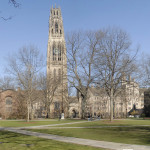Last Friday, Ta-Nehisi Coates closed his remarks on the case for reparations by saying that slavery isn’t a bump in the road of US history—it is the road. Prof. Kelly Lytle Hernández opened her talk, “Caged Birds: The Birth of Mexican Imprisonment in the United States,” with a similar metaphor that cuts to the quick of systemic racism and the modalities of state oppression in this country. Quoting Patrick Wolfe, Hernández reminded us that “settler-colonialism is a structure, not an event,” and invited us to think of mass incarceration as a project of genocide.
The U.S. currently has over 2 million people incarcerated—the largest prison population in the First World—and the nation’s prison complex is the second largest employer in the entire country. Imprisonment is one of the most lucrative industries in our country. Yet it is only recently that scholars have begun the hard work of understanding how the fact of imprisonment fundamentally shapes our culture, our political frame of reference—and the very way we think and act.
Hernández’s talk is the second lecture in the Ethnicity, Race and Migration Program’s Spring Lecture series in Latin@ Studies—a schedule of events that seek to account for the underrepresentation of non-white histories, philosophies, and cultures in our curriculum, and combat the epistemic oppression that comes hand-in-hand with such exclusion. Hernández spoke about the real, flesh-and-blood effects of such underrepresentation: Her lecture traced how the settler-imperialism of Anglo-America created the road to Black and Brown mass imprisonment today.
To explore both the criminalization of immigrants and the alienation of citizen offenders in the U.S., Hernández delineated how immigration control and mass incarceration emerged at the same time and place as forms of social control over who she calls a “racialized caste of outsiders in the United States today.”
To tell this story, Hernández dropped us down in California at the turn of the century. Today, the state has an incarceration industry that generates $1 billion a year. Los Angeles has the largest prison population of any city in the state, and, in a country where Blacks, Latin@s, and Native Americans make up over half of those held in detention, L.A. prisons are overwhelming Hispanic. If you were to look at L.A. in the 1860s, Hernández said, these ratios would be much the same.
In the U.S.-Mexican borderlands, mass incarceration became a tool to create, contain and consolidate white control over the most Western part of the country. This was the age of Manifest Destiny; the KKK was once again on the rise, as were Nativist groups, eugenics, and Jim Crow.
We can also see paths of immigrant labor and capital beginning to carve themselves like deep and familiar scars: At the close of the 19th century, few Mexicans lived in the United States, but American industries that demanded cheap mass labor were beginning to grow. And so by 1929, 10% of México’s population resided within U.S. borders, working and dying in factories and fields.
In a stunning attempt to both reaffirm racist and xenophobic attitudes towards Mexicans and hold on to their necessary labor, U.S. industrialists made the argument that immigrants from South of the border were “homers.” “Like a pigeon,” they said, the Mexican “goes home to roost,” meaning that L.A., the “Aryan City of the Sun,” could stay white, while maintaining a vast class of brown, “pigeon” workers—i.e., my great grandparents.
As federal prison facilities in the American borderlands expanded throughout the 1930’s, so did legislation meant to criminalize immigration. The Immigration Act of March 4, 1929 made “unlawfully” entering the U.S. a felony punishable by a fine and a prison sentence of up to one year. The majority of detainees who filled these new facilities were arrested on public order charges: that is, laws meant to deny racialized “others” the right to occupy space and live.
These are the same kinds of laws today that validate “Stop and Frisk,” killed Eric Garner, and send thousands of people each year into the hands of Immigration and Customs Enforcement—to be deported and ripped away from their families, their jobs, and their lives.
History tells us that “citizen,” like “human,” is a fundamentally exclusionary category. The simultaneous imprisonment and elimination of entire groups of people is written into the formation of this nation, just as the elimination of entire histories is written into the very way we think about the past. Lessons like these remind you of how little you’ve been taught—and why that is. One type of erasure always leads to another.
by Ava Tomasula y Garcia

